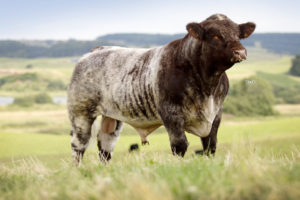Sweeper Bulls?
19 January 2018 Continuing advances in AI, automatic heat detection, synchronisation programmes along with larger herds and tighter calving periods means sweeper bulls are more common. This is particularly true in block, spring calving dairy herds where sweepers are turned out after an initial 4 – 6 weeks of AI.
Continuing advances in AI, automatic heat detection, synchronisation programmes along with larger herds and tighter calving periods means sweeper bulls are more common. This is particularly true in block, spring calving dairy herds where sweepers are turned out after an initial 4 – 6 weeks of AI.
Problems Of Teasers
- Breeding value.
Traditionally the cheapest bulls possible have been used as teasers on the basis that they will sire only a few calves. However bulls tend to be cheap because either they are difficult calvers or they produce poor quality calves! This approach therefore increases the “cost” of a sweeper bull made up from the low number of calves he sires, their low sale price, due to their poorer quality and being born late.
- The number of cows the bull has to “sweep”. This will depend on whether cows have been synchronised or have been AId on observed heat. Returns of cows which have been synchronised will also be partially synchronised, but the majority will be spread over at least 5 days. The following table shows the percentage returns to a synchronisation programme with differing levels of conception rate.
Number Of Sweeper Bulls Needed After Synchronised AI
| Conception rate to sync (%) | Potential returns | No. sweeper required/100 cows++ | Potential returns after double sync | No. sweeper required/100 cows++ | ||
| % | %/day+ | % | %/day+ | |||
| 50 | 50 | 10 | 2 | 25 | 5 | 1 |
| 60 | 40 | 8 | 2 | 16 | 3 | 1 |
| 70 | 30 | 6 | 2 | 9 | 2 | 1 |
+ assuming returns spread over 5 days
++ assuming a maximum of 5 cows served/day
With a single synchronised AI there will be 6 – 10 returns daily for conception rates to AI of 70 – 50%. Assuming a sweeper can successfully cover no more than 5 cows per day this would require 2 sweeper bulls saving just 1 bull compared to the 3 normally used with natural service.
Using a double synchronisation system where following the first AI cows are resynchronised and those detected in heat inseminated again, the number of returns is considerably reduced, only needing 1 sweeper per 100 cows synchronised. This of course assumes that 100 cows and calves can be run in a single group being covered by just 1 sweeper! The number of cows needed to be covered by the sweeper can be reduced by scanning 35 days after first AI. The cows scanned pregnant to the first service can then be split from the main group to make the sweeper bull breeding group a more manageable size. The only down side of this is if there is some late embryo death then they miss a change to re-breed.
Using sweeper bulls after a period of AI to observed heats gives a completely different picture. The number of returns at each conception rate, will be the same but spread out over the 21 day cycle so that 1, fit and fertile sweeper would be able to cope in all situations, providing again that 100 cows and calves can be run together in a single group.
- Sweepers must be fit and fertile.
In both situations sweepers will be expected to serve several cows per day over a relatively short time period. To do this they need to be both physically fit and fertile, making an annual MOT for them critical. It is certainly not a job for either young bulls who will “serve themselves silly” and deplete their semen reserves when faced with several cows in season at the same time nor for the old bull to have an easy time at the end of his days.
- Annual costs.
Ignoring depreciation for teaser bulls, they will have exactly the same annual variable costs as any breeding bull. A conservative estimate would be over £1,000 per head per year. (This is why a critical part of the profitability from using AI is being able to run fewer breeding bulls.)
Basil Lowman, SAC Consulting Beef Specialist
Sign up to the FAS newsletter
Receive updates on news, events and publications from Scotland’s Farm Advisory Service
